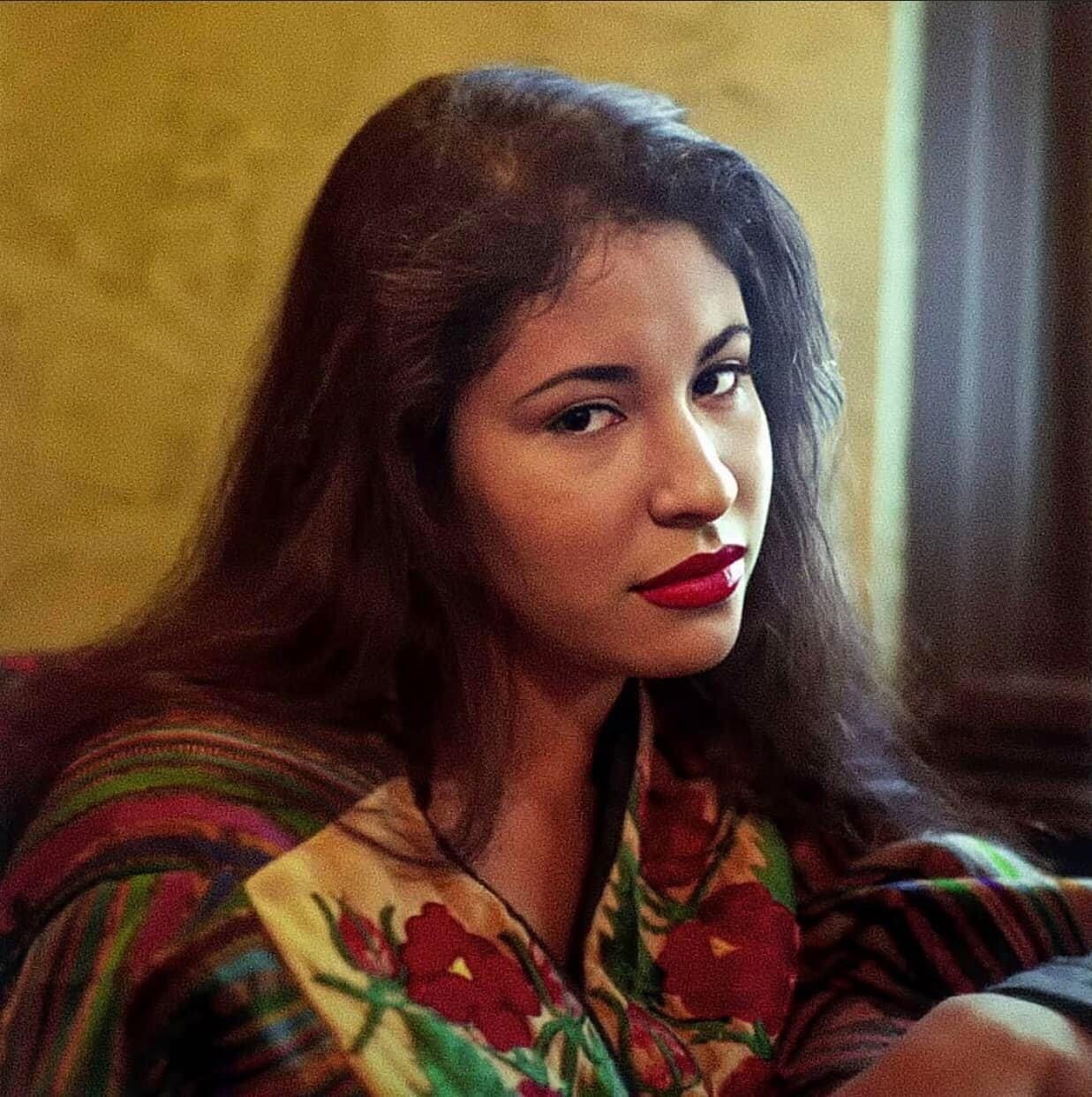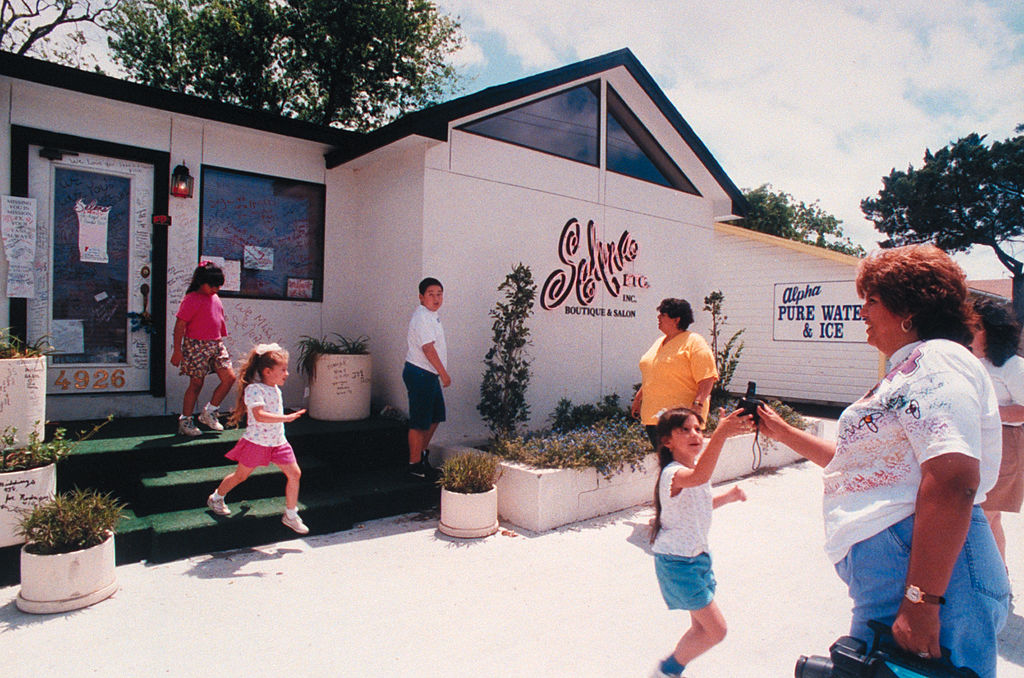Table of Contents Show
April 16th is recognized as Selena Day. This year in memory of Selena, we put on our favorite sparkly bustiers and play her Tejano classics, remembering her life and her contributions to the world. In her life, Selena Quintanilla-Perez became a widely popular female Tejano music star in an industry previously dominated by men, won various music awards for her talent, showed her love of fashion by opening a boutique, and was involved in her community through donations, free concerts, and other charity. To the whole world’s shock, Selena would be shot by the president of her fan club, dying an untimely death at 23. Despite her tragic death, Selena’s contributions to the world are still prevalent today, as she represents one of the most iconic Latina artists of all time.
Selena’s Early Life And Career
Selena Quintanilla-Perez was born April 16th, 1971, in Lake Jackson, Texas, to parents Abraham Quintanilla and Marcella Samora. Selena’s father, Abraham, was a former musician and managed and produced his family’s music group, Selena y Los Dinos, which included her elder siblings A.B. and Suzette. Selena’s talent was apparent from an early age, and she was performing at the young age of 10 as lead singer in the group Selena y Los Dinos. She grew up on the stage, performing for crowds with her family. “Her timing, her pitch were perfect; I could see it from day one,” Selena’s father Abraham told People magazine.

Selena was taken out of school in eighth grade to tour as a musician and received her high school diploma at 17. At first, people questioned her singing Tejano, as most female Tejano musicians failed. Then she was discovered by Rudy Trevino, founder of the Tejano Music Awards. In 1987 she won the Tejano Music Award for Female Vocalist of The Year — and then won nine consecutive times afterward.
Selena’s Career And Monumental Moments
In April of 1992, Selena and the guitarist in the band Selena y Los Dinos, Chris Perez, got married. Even though their relationship was bumpy from the beginning, with disapproval from Selena’s family and especially her father, Perez would soon be accepted into the Quintanilla family. A month after her wedding, Selena dropped her third album, Entre a Mi Mundo, which would be known as her “breakthrough album.” For eight consecutive months, the album would dominate as number one on the US Billboard Regional Mexican Albums chart. Furthermore, Entre a Mi Mundo would become the first Tejano album that sold over 300,000 copies by a female artist. The Mexican media fawned over Selena, and newspapers found her to be a refreshing change over the fair-skinned and blonde-haired telenovela actresses. Selena’s popularity grew in Mexico as she played several concerts throughout the country, and 70,000 people attended one of her shows, making it the biggest Tejano act in Mexico.
Selena released Live! a year after Entre a Mi Mundo, which would have tracks that reached the top five songs on the US Billboard Top Latin Songs chart. In the 1994 Tejano Music Awards, Live! won Album of the Year. It also won the 36th Grammy award for Best Mexican/American album. Aside from music, she also had a passion for fashion and design. In 1994, Selena began designing and manufacturing her own clothing line and opened two boutiques in Texas. Selena also held two fashion shows to highlight her designs. Hispanic Business reported Selena earned over five million dollars from these boutiques, which ranked her in the top twenty wealthiest Hispanic musicians from 1993-1994. Before her death, she was in negotiations to open more boutiques in Monterrey, Mexico, and Puerto Rico.

Selena’s fourth album, Amor Prohibido, sold over 500,000 copies and popularized Tejano music with a younger and more diverse crowd. Media outlets would begin describing Selena as bigger than Tejano music itself, and would name her the “Queen of Tejano.” Billboard magazine ranked Amor Prohibido as one of the most essential Latin records in the past 50 years, and NPR ranked it number 19 in their list of most influential albums made by women. After making it big in the Spanish market, Selena began preparing for her cross-over album to become an English star. The influence of Selena is unquestionable, as she built herself from the ground up to become one of the most popular and influential Latina musicians of her time.
Selena’s Early Death
The Quintanilla family appointed Yolanda Saldívar as manager of Selena’s boutiques in early 1994. Eight months later, Selena signed Saldívar as a registered agent in San Antonio, Texas. After this agreement, Saldívar moved to Corpus Christi to be closer to Selena. Yet by early December of 1994, Selena’s boutiques began suffering under the management of Saldívar. Both stores were short-staffed as Saldívar fired employees recklessly if she disliked them, and those closest to Selena began questioning Saldívar’s motives. Additionally, reporters from The Dallas Morning News stated that during an interview with Saldívar, it seemed her devotion to Selena bordered on obsession. Despite her family’s and other employees’ dislike of Saldívar, Selena continued to see the best in her, believing she was harmless.
After fans began complaining that they had paid for a Selena fan club membership and received nothing in return, Selena’s father began investigating the situation. He discovered Saldívar had embezzled more than $30,000 from the fan club and Selena’s boutiques. Abraham Quintanilla held a meeting with Selena and her sister Suzette, confronting Saldívar over the missing funds. Abraham Quintanilla warned Saldívar that he would get the police involved if she did not provide evidence against this. Despite this, Selena was hesitant to dissolve the friendship, believing Saldívar would be essential to the success of her clothing line in Mexico. Saldívar also had bank records, statements, and other financial paperwork essential for taxes.

Days before Selena’s death, Yolanda Saldívar delayed handing over financial records and bank statements to prove her innocence, stating she had been physically and sexually assaulted in Mexico. Selena took Saldívar to be examined for assault, but the two could not get a rape kit because Saldívar was not a resident of Corpus Christi, and the assault had happened in Mexico. After the examination, the two went back to a motel, where Selena demanded that Saldívar hand the financial records over. At this point, Saldívar pulled out a gun and shot Selena through the right lower shoulder, severing an artery and causing extreme blood loss. In an attempt to escape, Selena would reach the front desk and name Saldívar as her assailant.
Tragically, she would die later that day from blood loss and cardiac arrest. Selena’s murder shocked the nation. Major television networks stopped their broadcasting from announcing Selena’s death, and her death was on the front page of the New York Times for two days. It is estimated that more than 60,000 mourners attended her funeral. On April 12th, two weeks after her murder, Texas governor George W. Bush declared her birthday, April 16th, to be Selena Day. When Selena died, the world stopped for a moment. It is heartbreaking to think of the potential Selena still had awaiting her successful career and how the world was robbed of one of the greatest female musicians.
The Lasting Influence Of Selena
Selena’s influence as a Mexican-American icon lasts to this day. Selena embraced her Mexican heritage, broke barriers in Latin music, and embodied courage, kindness, and innovation for her fans. She cared about her fans and spent much of her time giving back to the community that loved her. She felt it was important to encourage kids and young adults to stay in school and spoke in various schools about the importance of getting a high school degree and following your dreams. Selena was known for her charity, giving free concerts to Texas schools, donating to school programs, and volunteering as a spokesperson for D.A.R.E. (Drug Abuse Resistance Education).

After her death, the Selena Organization was founded with the mission statement:
“To offer the motivation that every child needs to complete their education, to live moral lives, to love their families, to respect human life and to sing whatever song they were born to sing.”
The foundation continues to donate to different needs in honor of Selena’s memory. Selena was not only a successful female artist but a successful woman of color in the cut-throat music industry. Selena’s embracement of Tejano music spread pride in the Mexican-American communities in Texas and across the States. Her fashion statements and choices became trends, and she made it cool to be proud of your culture. Throughout Selena’s life and career, her passion for music and spreading love created a lasting impact that can still be seen to this day.
